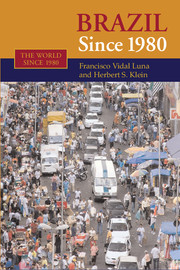Book contents
2 - The Economy
Published online by Cambridge University Press: 03 June 2010
Summary
The Antecedents
The Brazilian economy experienced growth for the first seventy years of the twentieth century. Initially sustained by the exportation of coffee and later by a process of induced industrialization through the substitution of imports, the country created an ample and complex industrial structure without parallel in Latin America. By the late 1970s, Brazil had established an industrial structure that included an important capital goods sector. The continental size of the country created a market of a scale sufficient to sustain not only a consumer durable goods industry but also one that could produce both basic inputs and finished capital goods. This long process of growth was broken by a series of external crises that affected Brazil and the majority of the developing countries at the end of the decade of the 1970s. The crisis began to unfold with the first oil shock of 1973, was reenforced by the second one of 1979, and was followed by the External Debt Crisis of the 1980s. These shocks, for both Brazil and the rest of Latin America, broke their long trend of growth in the twentieth century. In the case of Brazil, the average rate of growth, which had been 5.7 percent per annum by the last years of the 1970s, dropped to 2.1 percent in the last twenty years of the century.
- Type
- Chapter
- Information
- Brazil since 1980 , pp. 37 - 77Publisher: Cambridge University PressPrint publication year: 2006



